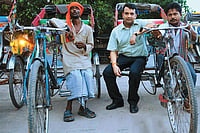Our current crop of youngsters don’t know Nipper, the dog. However, show the iconic picture of the dog peeking into a gramophone to someone from Generation X or earlier and they will tell you HMV is short for His Master’s Voice. The music label, owned by Saregama India ruled India’s music intellectual property scene for nearly five decades post-independence. Even today, the music company has a library of 1.2 lakh songs (in 18 languages). But Nipper, who fetched cash for its master for decades, vanished from India’s music scene two decades back.
Vikram Mehra, managing director, Saregama India, has no qualms admitting to the lost decades. “Yes, we were absent from the Bollywood music acquisition scene. We didn’t buy film music after the ’90s.” Interestingly, today he is back in his office after releasing the music for Vidhu Vinod Chopra’s Ek Ladki Ko Dekha Toh Aisa Laga. The film’s title harks back to the popular song from the film 1942: A Love Story. “Incidentally, we were also the music distributors for Vidhu’s film, 1942: A Love Story. That was 25 years ago. We began acquiring mainstream Hindi film music only last year, but we are back in the game,” says Mehra.
In its first comeback year, Saregama acquired music for Bollywood films such as 102 Not Out, Babumoshai Bandookbaaz, Saheb Biwi aur Gangster 3, and Kahani 2. The brand’s strategy — to stick to medium-sized projects — seems logical since music rights for big-banner movies sell for as much as Rs.250-300 million. Price notwithstanding, making a comeback in a space dominated by big hitters such as T-Series, Zee Music Company, and Sony Music is difficult. However, in the past one year, the label has made its way back to the limelight. This time, not for the chartbusters HMV was known for in its heyday, but for something else — Carvaan.
Carvaan, Saregama’s portable retro-style, music-player, comes pre-loaded with 5,000 classic Hindi songs from ’50s to ’80s. It does away with the need to hunt for music online, a major hang up for the 40+ demographic. “In 2015, we conducted a big study about music consumption behaviour in India. The feedback was that, for anybody above 40 years, accessing music was a huge hassle,” says Mehra. The consumer, they realised, was missing the good old days of MW radio playing in the background.
“The consumer is saying, I don’t want to be in control. Perhaps, we need to give them a product which takes away the hassle of searching for music. Carvaan is not just about music. You press a button, and for the next 24-36 hours, you need not worry about an internet connection, or anything for that matter,” says Mehra.
Designed and conceptualised in-house, the product has single-handedly breathed life into the company’s balance sheet. In fact, the brand’s top-line has grown over 1.5x in less than two years since the player’s launch. This gives the label the bandwidth to buy more film music rights. Irrespective of language, film music accounts for the lion’s share of all the music produced in India, and Saregama had not shopped for a long time.

For a brand that lived off its success for two decades, Carvaan has proved a big hit for Saregama India (see: Reaping rewards). A staggering million units have gone off the shelves in less than 17 months of its launch.
What Changed?
Mehra and his team are receiving all the attention and accolades for Carvaan. But what really changed for the company? Has Saregama become a consumer product company, from a pure music label? The company’s financials definitely suggest so; a good chunk of the top-line is driven by Carvaan.

Music as a vertical contributes 83% to Saregama’s revenue (see: Striking the right note). The latest available numbers show that the revenue in H1FY19 has moved up to Rs.2.25 billion from Rs.1.18 billion in H1FY18. That’s nearly a 100% growth in a year. Mehra refuses to comment on the financial numbers. However, analysts say Carvaan has been driving the top-line and bottom-line for the company.
“We are expecting 700,000 and 800,000 Carvaan unit sales in FY19 and FY20 respectively, including all variants. We expect Rs.2.8 billion and Rs.3.52 billion revenue from the B2C segment (Carvaan and its variants) in FY19 and FY20,” says Bhupendra Tiwari, an analyst at ICICI Securities. Carvaan has also turned Saregama into a retailer for the first time. “Fifteen months back, we were not present in a single store. Today we have 17,000 retail points,” says Mehra. Carvaan retails at electronic and gifts stores across the country. You will find them in electronics stores such as Croma, Vijay Sales, Reliance Digital; and even on e-tail platforms such as Flipkart and Amazon.
To Mehra, Saregama remains a content company. It is not transitioning into a consumer product company, he insists. “As a content company, our strategy and our work is pretty well cut out — how do we distribute our IP more widely and expansively, even while we buy new content?”
Carvaan is seen as a carrier of Saregama’s IP, their music. “Only Saregama can launch anything like this because we own a massive library of music from that age,” says Mehra. The margin is as high as 25% on the Carvaan box, sold for Rs.5,990. Newer, more premium versions have also been introduced at up to Rs.14,990 per unit.
Besides Carvaan Hindi, Saregama has also launched the device for its Tamil, Marathi , Bengali, and even Punjabi-speaking audience. While the company is tight-lipped about variant-wise breakdown of its sales volume, they are clear about innovating with the product. They are reaching niche products such as the Carvaan Mini and are also constantly upgrading the device with better speakers and more features such as the companion app.
With plummeting data prices and rising smartphone ownership, an internet-based solution seems more appealing. The likes of Gaana, Saavn, and Wynk have successfully captured space on our smartphones. Even Spotify is expected to be operational in India soon. Intuitively, streaming seems to be the future of music.
“Entertainment has been the single biggest beneficiary of internet explosion in India and music is the single biggest driver of that,” says Siddhartha Roy, CEO, Hungama. Number of active users on Gaana, Times Internet’s music app, has also leaped to an 80 million a month. Prashan Agarwal, CEO, Gaana, says, “The streaming market has been growing at 100% year-on-year across all the languages over the past two years. Of the total music industry revenue, 50% comes from music streaming companies now.”
Mehra believes distribution channel holds lesser significance than content, which is Saregama’s strong point. He worked at Star Network and Tata Sky before joining Saregama four years ago. “From my experience I say, you may package content in various ways, distribute through Over The Top (OTT), cable, satellite, or apps but there is only one king — content. We have no intention to get into the internet (streaming) platform space,” he says. The company will continue sharing its content with platforms such as Gaana, Wynk, Hungama, Spotify, Saavn, Youtube, and telecom carriers — all are the company’s B2B content partners.
Carvaan’s growth will not be affected by these partnerships for two reasons. First, it caters to a different demographic and, second, it doesn’t function in the music streaming domain. “This (content-sharing) business has been a cash cow for Saregama. With the uptick in internet usage, the B2B business has also seen an 18% growth in the past one year,” says Tiwari of ICICI Securities.
Growth Driver
Saregama has newfound confidence to bid for new Bollywood music and make movies. The success of Carvaan has sent the label’s cash registers ringing, allowing the company to deploy more resources for content buying and creation for TV and films now (see: Widening horizons). While it has been making Tamil language TV serials for more than a decade, it started Yoodlee Films in 2017 (the same year Carvaan was conceived). The idea is to make low-cost films and sell them to digital networks such as Netflix, Amazon, and Zee5.

The label partners with promising directors who can make content-oriented films which appeal to the digital audience. The strategy is to make low-budget films (Rs.40 million to Rs.50 million); shoot quickly (20-22 days); share profits with actors to contain costs; choose subjects that appeal to millennials such as relationships, stardom, sex, comedy and terrorism; and sell to digital networks. “All our films are shot in high-def 4k, we always shoot on location (never on sets), and we allow a maximum of 10% dubbing. We are the only people who offer a 30% profit-sharing with key artistes; the director and actors,” says Mehra.
Four of their films — Brij Mohan Amar Rahe, Kuch Bheege Alfaaz, Ajji, and Ascharyachakit — have made it to Netflix. The details about their revenue agreement are not known. However, as per analysts, once the brand has a catalogue of films, that is, 25-30 in a few years, the realisations will be better. Saregama is just about to announce a deal with an undisclosed entity who will buy a guaranteed number of movies from them each year.
“The travel time for commuters is constantly going up, even in tier-II cities. With time on your hand and a device, you end up listening to music or watching content. It is also okay for two people in the same room to watch different content on different screens. We want to ride on such a social phenomenon,” says Mehra.
The OTT market in India has global giants, such as Netflix and Amazon, and the likes of Voot, Hotstar, and ALTBalaji. Besides traditional films, these producers look to procure original content, given its increasing popularity. Saregama plans to have a kitty of 25 such films over the next three to four years. They are targeting the 18-35 age group, which is digitally savvy and likes story-led films.
But have they made any money with the movies? “Our movie business is even younger than Carvaan,” says Mehra. Their first movie was Ajji which released in November 2017. The low-profile movie received critical acclaim but didn’t do so well at the box office.
The films are to be monetised largely on digital platforms but analysts are sceptical. “It is still an untested territory for the company and successful monetisation could be a challenge here considering the limited promotion, lack of a big star cast and unproven record,” says Tiwari. Films and TV, comprising largely of Tamil soaps contribute less than 15% (about Rs.530 million) of the company’s revenue (see: Long way to go).

Saregama still cannot take on big boys such as T-Series, Zee Music and Sony Music head on. “The big-ticket deals can be between Rs.250 million and Rs.300 million for music rights of a movie. Annual revenue of T-Series (Super Cassettes Industries) is estimated to be over Rs.25 billion and that of Zee Entertainment Enterprises (of which Zee music is a part) is Rs.71.26 billion. With revenue of a relatively modest Rs.3.56 billion for FY18, Saregama’s balance sheet doesn’t allow it such bets,” says an industry expert who wants to remain anonymous.
Then what can help grow the size of the brand’s balance sheet? Carvaan has driven their top-line growth in the past two years, but can it maintain this momentum?
Roy says, “Carvaan is a great product though only for a certain set of people.”
Agarwal believes what worked for Carvaan was also how it was marketed. “That it was positioned as a gifting option in an under-served market. The young are earning money but had no novel gifting options for their parents.”
This may appear to be a fad to others but not to Mehra. He believes, Saregama has only scratched the surface, and the party will continue. Before launching Carvaan in 2017, Mehra and his team conducted a detailed music consumption study of the market. “The size of the addressable market, based on affordability and with people above 40 years of age, is 25 million Indian homes… we still have a big headroom.”
Industry experts, however, are of the opinion that, to multiply sales, the company has to constantly innovate and update Carvaan.
Kiran Khalap of Chlorophyll brand consultancy, credits authenticity, simplicity and meaning to the success of Carvaan. “Because we are overwhelmed with choice, we yearn for simplicity.” But Khalap believes the nostalgia, or retro appeal, can’t sustain any product beyond a point. “Paper Boat had to find newer and newer ways to connect. The other maxim in today’s marketing is to do a 365-degree approach to marketing as against the older 360-degree approach. Don’t just connect with the customer with the product but by other ways. Can they create a Carvaan Antakshari? Can the users vote for the best songs from the ’60s? Can Saregama develop campaigns to generate customer engagement? Such activities will help sustain sales momentum,” he says.
Saregama has already launched regional players and niche ones. Carvaan Tamil and Marathi were introduced in 2018, each with 5,000 songs. Mehra claims they all enjoy a similar advantage regionally. “HMV was active in every language. We have the biggest Tamil and Bengali library. Especially Carnatic and devotional music.”
Mehra’s claims come as no surprise. Saregama is one of the oldest labels in India. They released India’s first studio recorded song in 1902, and own an impressively large library of film and non-film music in 18 languages.
In the niche space, they have launched Carvaan Mini, Carvaan Gurbani, and Carvaan Subbulakshmi. These are smaller devices about the size of your average Bluetooth speaker, have fewer songs (351 tracks), and as a result, retail at Rs.2,490.
Isn’t that too little value for a customer looking forward to an endless nostalgic play? Mehra reveals that Carvaan Mini is positioned differently from Carvaan. “The Mini targets a younger audience, the age group of 25 to 35. It has fewer songs, but they are all super-hit tracks. It exposes them to the best songs from that (1950-80) era.” Mehra didn’t disclose sales numbers on Carvaan Mini.
Mehra says, they are spending a lot of time with their consumer base to figure out what they want. All the inputs are being used to create new variants of Carvaan. Integration with internet was one such input. Saregama launched the Carvaan app in September 2018. With this free companion app, a user can create a playlist of his or her favourite songs. For now, the app only works for Carvaan Gold and Carvaan Premium. However, it has seen over 100,000 downloads.
To give Carvaan a more premium appeal, Saregama launched a variant with Harman speakers in December 2018. It retails at Rs. 14,990. “It is the first partnership of its kind globally where they (Harman) have embedded their stuff inside a product,” says Mehra.
Kanwaljit Singh, founder of Fireside Ventures that invests in consumer product companies, is a user of Carvaan. On a premium version’s pricing, he says, “That sounds a little counter-intuitive as a consumer. Maybe, at a significantly higher price-point, the Harman variant will attract the top-end consumer who wants to gift a high-value product. But there’s another other major attraction of Carvaan: there is something romantic about the quality of sound. It is not of the highest quality. You can expect old scratchiness, which used to be there in radios, and that reinforces nostalgia”.
With Carvaan, Saregama seems to have begun a whole new journey. However, it looks like the company that released India’s first ever studio recorded song over a century ago will have to keep reinventing itself to recreate its glory days.





























